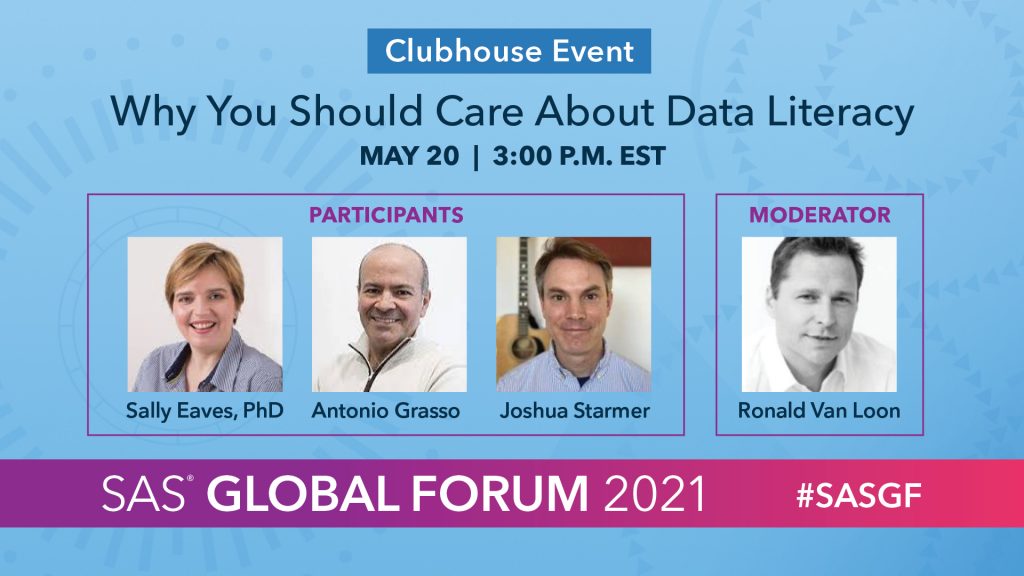Our traditional assumptions about data are evolving, and so is our understanding of data literacy. Data is more than numbers, charts and graphs. And data literacy is not just for data scientists.
“If you’re talking with people who aren’t already data fluent, you have to make them aware that data is everywhere in the world,” explained Kirk Borne during a recent Clubhouse conversation. “Even my face is data because it unlocks my mobile phone.”
Borne, who is the Chief Science Officer at Data Prime AI, said, “Look at the various apps on your smartphone. It’s all data. Once you realize that we are all generating data and consuming it every day, it’s easy to ask, ‘Why don’t you be part of that revolution too?’”
It has never been more important to be data literate. Whether you work with data as part of your job or simply want to navigate life in modern society, understanding the data around you can help you succeed.
These issues were explored in a recent Clubhouse Event, “Why You Should Care About Data Literacy.” Ronald van Loon, CEO and Principal Analyst at Intelligent World, hosted the conversation, which was sponsored by SAS in conjunction with SAS Global Forum.

Understanding the value of data
“Everyone across the organization needs to understand the value that data brings to the organization and how they can use data to improve their role.” Said van Loon to kick off the event.
Many people make assumptions about data without realizing it, said Marcia Walker, a Principal Industry Consultant at SAS. “Not everyone has come to the realization that imagery and sound are data now,” explained Walker. “Even a few years ago, we weren’t able to take advantage of these data sources because we didn’t have the computing capacity. Now we have built-in algorithms to deal with all kinds of data.”
Walker recommended looking outside your normal box of what data is available to you. Think beyond Six Sigma, supply chain, and consumer data and consider audio, video, images – and more. “Once you see these things are data, then determine, how can you use it?”
Data literate organizations are already asking these questions and finding new data sources and new technologies to understand data.
Over the past year, the pandemic revealed that some organizations weren’t as data driven as they thought they were, said Wilson Raj, Director of Customer Intelligence at SAS. “For good or for bad, the pandemic accelerated data literacy. It brought more contactless purchases, more varieties of data, and even accelerated the use of augmented reality to create virtual immersive experiences. Data literacy is a building block for really delivering on some of these brand experiences.”
Data literacy for everyone
“I love that we’re talking about the importance of employees being data literate,” said Lucy Kosturko, pointing out that AirBnb and American Red Cross are rolling out data literacy initiatives across their organizations. These programs acknowledge that, “In order for us to be data literate companies, it requires scaling this skill set to make sure everyone has this level of functional data literacy,” said Kosturko.
Kosturko, a SAS Education Outreach Specialist, defines functional data literacy as the ability to use data to navigate everyday life.
Joshua Starmer, a statistics instructor and blogger at StatQuest, agreed about the importance of data literacy for everyone. “We’re at a critical time where data is being used and heavily abused to sway opinions,” explained Starmer. “It’s important for people to become more astute to see how data can be manipulated for a narrow definition.”
Starmer encourages students and clients to use data to find and understand the whole story. “Something I’m trying to help people do is to learn the whole story, to ask questions of the data, to interrogate it, to think critically of it and not just be governed by a knee-jerk reaction of something they see on the internet.”
Kosturko is passionate about preparing students with functional data literacy skills across the curriculum. The first step is data awareness, which goes back to the idea that data takes on all these different forms.
“People do a good job of making data science look expensive and complicated. Data literacy should be seen as more pedestrian,” said Kosturko. For example, if you walk into a basketball game at a local high school, you can see which side is the home team because more people are sitting there. That’s data, said Kosturko.
“Bringing this awareness that you’re dealing with data every day and there’s value in data and you’re already good at it is important for teaching data literacy,” she said.
Once students have that awareness, as they get older and go into the workplace, they bring it with them. They already see the value in using data to make decisions.
Starmer starts by generating a curiosity in data. He suggests asking, Who generated it? Where it was generated? What were the data collection methods and results? What is analysis going to be used for? “It’s important to speak in the language of the people you’re teaching,” said Starmer.
“Data literacy is an important aptitude for any person in the modern workforce,” argued Borne. “Certain skills are needed for every job. Some people will become data scientists or mathematicians. Not everyone will become experts but every single person needs to have an aptitude in numerical literacy, reading, writing and data.”
Shape the future with data: Take our data literacy essentials course for free